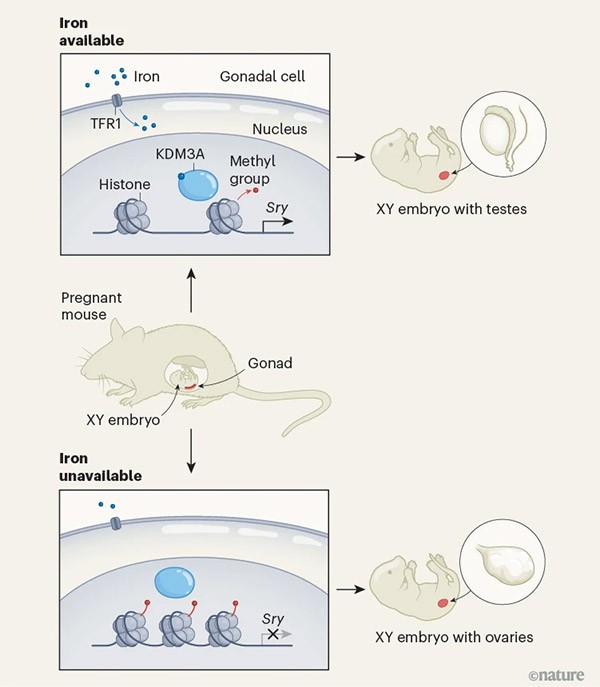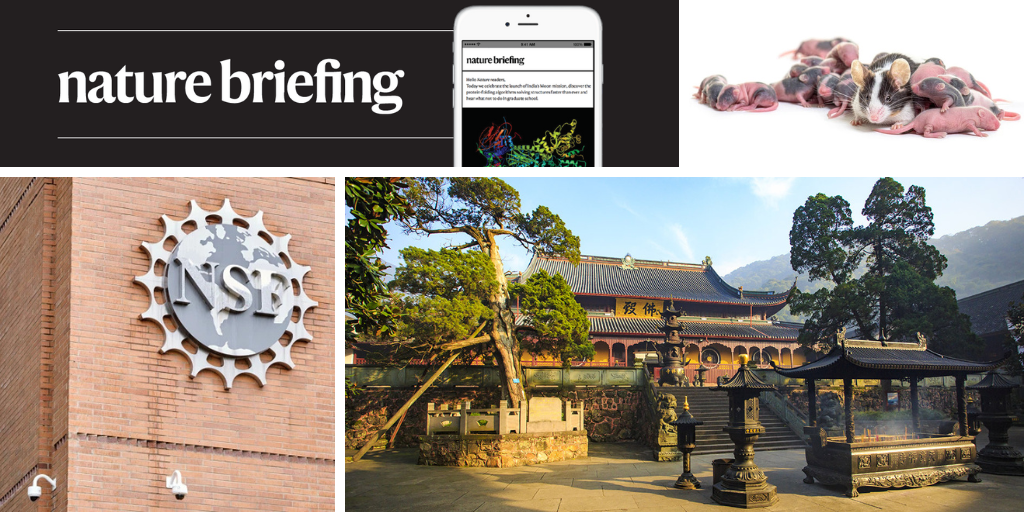You have full access to this article via your institution.
Hello Nature readers, would you like to get this Briefing in your inbox free every day? Sign up here.

A 1,200-year-old Platycladus orientalis (left) at Tiantong Temple in Zhejiang province, China.Credit: ViewStock/Getty
Buddhist and Taoist temples in China are providing a refuge for trees — the oldest of which has been growing for 2,000 years. A study of nearly 50,000 trees, each more than a century old, described nearly 61 threatened species, eight species that were found only on temple grounds and the only existing individual of Carpinus putoensis.
Reference: Current Biology paper
Male mouse fetuses can develop female organs in utero if their mother is iron deficient during pregnancy. When pregnant mice were given a molecule that sequesters iron, or their embryos had genetic tweaks that disrupted their iron uptake, a handful of pups with XY chromosomes in their litters grew ovaries. The findings could have implications for medical advice about iron intake during pregnancy, says molecular geneticist Vincent Harley. But as most embryos developed typical sexual characteristics, there must be other key factors that influence sex, he adds.

Mice with XY chromosomes usually develop testes if a gene called Sry on the Y-chromosome is activated and ovaries if it is not. Sry is activated by a type of enzyme called a histone demethylase (KDM3A), which needs iron to function. The enzyme removes chemical tags called methyl groups from stretches of DNA near Sry, which lets other cellular machinery access the gene. (Nature News & Views | 7 min read, Nature paywall)
Features & opinion
A young street performer in Pakistan who became famous for not feeling pain. A group of people in Alabama who felt excruciating burning in response to the slightest heat. Both had mutations in the SCN9A gene, which acts on the function of the tiny sodium channel called NaV1.7 that helps to conduct electrical signals in pain-sensing nerves. “We all went crazy, because people without NaV1.7 were pain-free but otherwise normal,” says molecular neurobiologist John Wood. “It was unbelievably exciting.” Eventually, this discovery helped to kick off the development of a promising new painkiller: suzetrigine. In January, the drug (marketed as Journavx), became the first new non-opioid painkiller in more than twenty years to receive approval for acute-pain treatment from the US Food and Drug Administration.
The situation will be familiar to many scientists: behavioural scientist Dritjon Gruda was asked to give a seminar, but when he quoted his fee, he was met with radio silence. Researchers often spend hours doing unpaid work, but there are ways to force you and any prospective partner to treat your labour as professional work, Gruda writes. Keep a tangible list of services and fees handy, bring up payment as soon as possible and seek support from your institution. “We need to break the illusion that all other academics are giving away their work for free,” writes Gruda.
Today I’m questioning my grasp on the laws of physics watching this bead roll down a vertical surface. The trick, researchers say, was finding a ‘Goldilocks’ balance of elasticity and texture when designing the polymer the orb is made of. Its unique properties give it just the right amount of stick to slowly roll without falling straight down.
Help us get this newsletter ‘just right’ by sending us your feedback. Your emails are always welcome at [email protected].
Thanks for reading,
Jacob Smith, associate editor, Nature Briefing
With contributions by Flora Graham
Want more? Sign up to our other free Nature Briefing newsletters:
• Nature Briefing: Careers — insights, advice and award-winning journalism to help you optimize your working life
• Nature Briefing: Microbiology — the most abundant living entities on our planet — microorganisms — and the role they play in health, the environment and food systems
• Nature Briefing: Anthropocene — climate change, biodiversity, sustainability and geoengineering
• Nature Briefing: AI & Robotics — 100% written by humans, of course
• Nature Briefing: Cancer — a weekly newsletter written with cancer researchers in mind
• Nature Briefing: Translational Research — covers biotechnology, drug discovery and pharma


